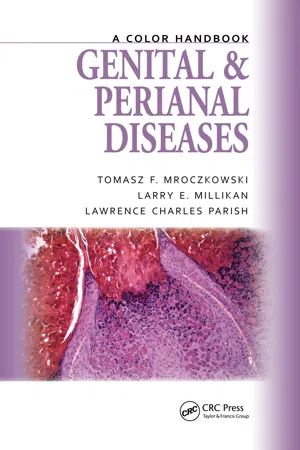Biological Sciences
Syphilis
Syphilis is a sexually transmitted infection caused by the bacterium Treponema pallidum. It progresses through stages, starting with painless sores, then a rash, and eventually affecting the heart and nervous system if left untreated. Syphilis can be treated with antibiotics, but if not diagnosed and treated early, it can lead to serious health complications.
Written by Perlego with AI-assistance
12 Key excerpts on "Syphilis"
- eBook - ePub
Genital and Perianal Diseases
A Color Handbook
- Tomasz F. Mroczkowski, Larry E. Millikan, Lawrence Charles Parish MD(Authors)
- 2013(Publication Date)
- CRC Press(Publisher)
SECTION 1SEXUALLY TRANSMITTED DISEASES
CHAPTER 1
Syphilis
Erin Santa, MD, and Joya Sahu, MD • Definition and epidemiology • Primary Syphilis • Secondary Syphilis • Early latent Syphilis • Tertiary Syphilis • Congenital Syphilis • TreatmentDefinition and epidemiology
Syphilis (Lues) is a chronic sexually transmitted infection caused by the spirochete Treponema pallidum . The disease is defined by primary, secondary, and tertiary stages, with intervening periods of latency. If left untreated, it may be either self limiting or progress, causing serious complications several years after acquisition. Pregnant women, if untreated, may pass infection to their infants transplacentally – congenital Syphilis1,2 .In the USA, rates of Syphilis fell by 95% between 1945 and 2000 with the advent of penicillin therapy3 . Unfortunately, in more recent years, there has been a steady increase in rates of the disease, specifically in men who have sex with men (MSM). In the early 2000s, rates of Syphilis were reported to be highest in MSM aged in their 30s; however, a recent study has shown that Syphilis is increasingly affecting younger MSM, those between the ages of 15 and 29, in addition to black and Hispanic MSM4,5 .1.1 Primary lesion in the early stage of development.Primary Syphilis
CLINICAL FEATURES
The primary infection usually appears after an incubation period, ranging from 10 to 90 days, with an average of 3 weeks. The initial lesion or ‘primary chancre’ appears at the point of inoculation, which is most commonly the genitals or anus. The first sign may be a dusky, red macule, which quickly develops into a pinkish papule and then a painless chancre with an ulcerated center (1.1 ). The classical chancre is usually solitary, regular in shape, round or oval, with clearly defined, raised, smooth borders, surrounded by a dull red areola or even normal skin (1.2 ). The base is finely granular, glistening, and clean (1.3 ), unless secondarily infected. On palpation, the base of the ulcer has hard button-like or cartilaginous induration. Squeezing or abrading the ulcer produces a serous or yellowish exudate containing spirochetes. The chancre of Syphilis is painless, unless secondarily infected. In heterosexual men it is most commonly found on the penis (1.4 ), while in homosexual men, the anus (1.5 ), rectum, or mouth, and in women the labia and the cervix (1.6 - Alan D.T. Barrett, Lawrence R. Stanberry(Authors)
- 2009(Publication Date)
- Academic Press(Publisher)
Chapter 59 Syphilis Lorenzo Giacani, Sheila Lukehart, Arturo Centurion-Lara Department of Medicine, School of Medicine, University of Washington, Seattle, WA, USA Abstract Syphilis continues to be a common and serious disease, affecting at least 25 million persons worldwide. It is a recognized cofactor in the transmission and acquisition of human immunodeficiency virus, and is a major cause of stillbirth and perinatal morbidity in the developing world. Despite the availability of safe, effective, and inexpensive diagnostic tools and treatment, Syphilis is still uncontrolled or has reemerged in many areas of the world, thus demonstrating the failure of conventional efforts to control transmission and emphasizing the need for an effective and practical vaccine. The peculiar biology of Treponema pallidum, along with the inability to continuously grow this pathogen in vitro, has hindered progress in this field. The public health importance of Syphilis prompted numerous vaccination attempts with whole cell vaccines in the mid-1900s. Only one protective vaccine has been described which, though completely protective in the rabbit model, cannot be translated for human use. The availability of new tools such as genomics, proteomics, and recombinant DNA technology permits today’s investigators to focus on the identification of surface-exposed antigens and other virulence factors to target their vaccine efforts. The combination of modern in silico analysis tools and biological assays has led to the identification of several promising candidate antigens, including the members of the Tpr family, newly identified adhesin molecules, lipoproteins, and other putative outer membrane proteins. While early subunit vaccine studies have not yielded complete protection, a number of antigens have induced sufficient immunity to significantly alter disease progression following infectious challenge- Sunit Kumar Singh, Sunit Kumar Singh(Authors)
- 2018(Publication Date)
- Wiley-Blackwell(Publisher)
11 Sexually Transmitted TreponematosesLenka Mikalová and David ŠmajsDepartment of Biology, Faculty of Medicine, Masaryk University, Brno, Czech Republic11.1 Introduction
Syphilis, first named in 1530 by Girolamo Fracastoro, is a well‐known example of a sexually transmitted treponematosis, which, before the invention of penicillin treatment, infected as much as 10% of the entire population of the United States in the early twentieth century (Rothschild 2005 ). The Syphilis‐causing Treponema pallidum subspecies pallidum (TPA) is very similar to the other pathogenic treponemes including T. pallidum ssp. pertenue (TPE), T. pallidum ssp. endemicum (TEN), and Treponema carateum, which cause yaws, bejel, and pinta, respectively. Syphilis is characterized by multiple clinically manifest stages (primary, secondary, and tertiary) that alternate with periods of latency. It is also the most invasive treponematosis, and it occurs globally. The ability of TPA to evade the host’s immune system, disseminate via the bloodstream to organs and tissues, and persist in affected individuals for decades are key characteristics of Syphilis pathogenesis. Endemic Syphilis, also called bejel, mainly affects children 2–15 years old and is transmitted mainly by direct skin‐to‐skin contact or by contaminated utensils. Primary lesions are painless and occur within the oral and nasopharyngeal mucosa. In the late stage, the nasopharynx, skin, and bones are affected. While there is a historical consensus that only Syphilis is sexually transmitted (reviewed by Giacani and Lukehart 2014 ), there is increasing evidence that TEN can also be transmitted through sexual contact (Turner and Hollander 1957 , Grange et al. 2016 , Mikalová et al. 2017a- eBook - ePub
- Marlene B. Goldman, Rebecca Troisi, Kathryn M. Rexrode(Authors)
- 2012(Publication Date)
- Academic Press(Publisher)
Chapter 30
Syphilis in Women
Jeanne M. Marrazzo∗ and Connie L. Celum†∗ Department of Medicine† Global Health, University of Washington, Seattle, WA, USAIntroduction and History
References to clinical syndromes consistent with Syphilis as a disease of humans exist in biblical and ancient Chinese records. The disease was so common in late 15th century Europe that it earned the sobriquet ‘the Great Pox’, aimed largely at distinguishing it from the concurrent scourge of smallpox.1 The bacterial etiology of Syphilis was discovered in 1905 by Schaudinn and Hoffmann, who named the corkscrew-shaped organism Treponema pallidum . By that time, the common clinical syndromes of Syphilis were well characterized, and included genital ulcers (called ‘hard’ chancres to distinguish them from the ‘soft’ chancres of chancroid), rash, cardiovascular and neurological complications, and numerous congenital abnormalities including spontaneous abortion, saddle nose deformity, and characteristic abnormalities of the teeth and bones (see the section ‘Syphilis and Pregnancy’). In the US, Syphilis was a leading cause of blindness and dementia during the first half of the 20th century. The discovery in the 1940s that penicillin, a widely available and affordable antibiotic, was highly active against T. pallidum heralded the possibility of eventual control of the disease. This hope was heightened when inexpensive and reasonably accurate blood screening tests for Syphilis – Syphilis serologies – became widely available in the 1940s. However, few infectious conditions illustrate so well the challenge of controlling a sexually transmitted infection (STI), whose viability at the population level depends in large part on complex socioeconomic factors. This challenge is currently manifested through the dramatic increases in the incidence of Syphilis among men who have sex with men (MSM) in many countries, with a high prevalence of concomitant infection with HIV-1.2The disease induced by T. pallidum is often characterized by clinical features that potentiate its perpetuation in the human population, with no physical signs or symptoms during much of its clinical course, and establishment of latency in sites relatively protected from immunological control (see the section ‘Natural History and Clinical Manifestations of Syphilis’). This allows for an infected person to unknowingly transmit T. pallidum - eBook - ePub
- Ayşe Serap Karadag, Lawrence Charles Parish, Jordan V. Wang, Ayse Serap Karadag, Lawrence Charles Parish, Jordan Wang(Authors)
- 2022(Publication Date)
- CRC Press(Publisher)
27Sexually Transmitted DiseasesAarthy K. Uthayakumar and Christopher B. BunkerDOI: 10.1201/9781003105268-27CONTENTS
Syphilis Gonorrhea Chancroid Lymphogranuloma Venereum Granuloma Inguinale Condylomata Acuminata Human Immunodeficiency Final Thought Additional ReadingsOverview: The global health burden of sexually transmitted infections (STIs) remains large and increasing. In developed countries, education and sexual health are more widely available, but the burden is greatest in resource-poor countries where health care is limited. STIs are caused by a wide range of microorganisms, and many have asymptomatic early infection which favors onward transmission. They are a potential cause of serious morbidity and mortality, with late complications including in pregnancy. Furthermore, coinfection with HIV affects transmission rates. Ease of diagnostic testing, combined with early and effective treatment and increased public education, are vital for gaining control.Syphilis
Definition: This is an infectious disease caused by the spirochete Treponema pallidum. It is usually acquired through sexual transmission, though can also be transmitted transplacentally causing congenital Syphilis. It can evolve through various stages, separated by variable periods of latency.Clinical presentation: The incubation period is 9–90 days. Primary Syphilis is characterized by the appearance of a chancre, representing the site of inoculation. This is a painless, firm, ulcer of variable size, between 0.5–3 cm in diameter, with a sloughy and indurated base. It is usually on the glans penis, prepuce, or shaft in men and the vulva in women; it can also appear in and around the mouth and around the anus in men who have sex with men (MSM). Chancres heal without scarring after 3–8 weeks if left untreated.The latent period between primary and secondary Syphilis can range between 2 months to 3 years. Approximately 25% of individuals with untreated primary Syphilis will develop an illness representing secondary Syphilis. - eBook - ePub
- Catriona Melville(Author)
- 2015(Publication Date)
- Wiley-Blackwell(Publisher)
The WHO estimated there were 10.6 million cases of this curable sexually transmitted genital ulcerative infection diagnosed worldwide in 2008. It remains a significant health problem in both the USA and in Europe. Following a sharp decline in incidence in the UK in the 1980s, the number of cases increased rapidly between 1998 and 2008. In the UK there are a disproportionate number of cases in MSM and the majority of infections are in people >25 years of age, although recent outbreaks in young heterosexuals have been reported. Generally diagnoses in men far outweigh those in women but this is predominantly due to the high incidence in MSM. Surveillance data are collected on early infectious Syphilis in the UK, USA and other countries.- Aetiology: Syphilis is caused by infection with the spirochete bacterium Treponema pallidum subsp. pallidum (other subspecies cause Yaws and Pinta). It has limited viability out with its host (obligate human parasite)
- Transmission: Syphilis is transmitted by direct contact with an infectious lesion (usually sexual); via infected blood products or needle sharing; or vertical transmission (mother to child) as it can cross the placenta at any stage of pregnancy. Sexual transmission can be via the anogenital or oral contact
- Classification (Table 16.1 )
Clinical features
Primary Syphilis
- Characterized by a chancre (ulcer) which is typically solitary, indurated and painless, with a clean moist base, exuding clear serum (Figure 16.1 ). The chancre is typically in the anogenital region
- Atypical presentation can occur with ulcers which are multiple, painful, purulent or destructive and can mimic HSV infection (Box 16.1 ). They can also be extragenital, especially oral and rarely finger, hand, arm and other sites. Balanitis of Follman is rarely reported
- The primary lesion is associated with regional lymphadenopathy
- Occurs 9–90 days after infection (average is 3 weeks) and resolves within 3–8 weeks. May go unnoticed by the patient particularly if painless
Secondary Syphilis
Haematogenous dissemination of infection causes multisystem involvement within the first 2 years of infection. Features are: - eBook - ePub
- S. R. Prabhu(Author)
- 2023(Publication Date)
- Wiley-Blackwell(Publisher)
[2] . The primary, secondary and tertiary phases have all been associated with oral lesions. It is therefore prudent for oral health practitioners to be familiar with the natural history of this infection and its associated oral manifestations.Natural history and clinical staging of Syphilis.Figure 1.1Source:Reproduced with permission from Spach and Mirchandani [2] .Epidemiology
Syphilis continues to cause morbidity and mortality worldwide. WHO estimates that 7.1 million new cases of Syphilis occurred among adolescents and adults aged 15–49 years worldwide in 2020 [1 , 3 ].Bacteriology, Risk Factors and Transmission
The etiologic agent in Syphilis is T. pallidum. Treponema belongs to the spirochete class and is a corkscrew‐shaped, motile microaerophilic bacterium that requires a live rabbit‐model system for culture and cannot be viewed by normal light microscopy. This spirochete bacterium is thin (0.1–0.18 μm in diameter) and 6–20 μm in length with typical corkscrew motion on dark‐field microscopy (Figure 1.2 ) [2 , 4 ].The major routes of transmission for T. pallidum are sexual (during the primary and secondary stages of Syphilis) and haematogenous (in utero via transplacental spread to a foetus) [2 , 5 ]. During sexual transmission, T. pallidum enters the body via breaches in skin and mucous membranes. Although sexual transmission of T. pallidum usually results from contact at genital mucous membranes, it can also occur at other body areas, including the mouth, anorectal areas and cutaneous lesions. Maternal transmission predominantly occurs via transplacental passage of T. pallidum during maternal spirochetemia; less often, transmission can occur if the newborn has contact with maternal genital lesions at the time of delivery [2 , 5 - eBook - ePub
- Marlene B. Goldman, Maureen C. Hatch(Authors)
- 1999(Publication Date)
- Academic Press(Publisher)
23Syphilis in Women
JEANNE M. MARRAZZO and CONNIE L. CELUM, Department of Medicine, University of Washington, Seattle-King County Department of Public Health, Seattle, WashingtonI. Introduction and History
References to clinical syndromes consistent with Syphilis as a disease of humans exist in biblical and ancient Chinese records. The disease was so common in late fifteenth century Europe that it earned the sobriquet “the Great Pox,” aimed largely at distinguishing it from the concurrent scourge of small-pox [1 ]. The bacterial etiology of Syphilis was discovered in 1905 by Schaudinn and Hoffmann, who named the corkscrew-shaped organism Treponema pallidum. By that time, the common clinical syndromes of Syphilis were well-characterized and included genital ulcers (called “hard” chancres to distinguish them from the “soft” chancres of chancroid), rash, cardiovascular and neurologic complications, and numerous congenital abnormalities including spontaneous abortion, saddle nose deformity, and characteristic abnormalities of the teeth and bones (see Section VIII ). In the U.S., Syphilis was a leading cause of blindness and dementia during the first half of the twentieth century. The discovery in the 1940s that penicillin, a widely available and affordable antibiotic, was highly active against T. pallidum heralded the possibility for eventual control of the disease [2 ]. This hope was heightened when inexpensive and reasonably accurate blood screening tests for Syphilis—Syphilis serologies—became widely available in the 1940s. However, few infectious conditions illustrate so well the challenge of controlling a sexually transmitted disease (STD) whose viability at the population level depends in large part on complex socioeconomic factors.The disease induced by T. pallidum is often characterized by clinical features that potentiate its perpetuation in the human population, with no physical signs or symptoms during much of its clinical course and establishment of latency in sites relatively protected from immunologic control (see Section IV ). This allows for an infected person to unknowingly transmit T. pallidum - eBook - ePub
- Ethne Barnes(Author)
- 2007(Publication Date)
- University of New Mexico Press(Publisher)
12: Syphilis The Great Change ArtistSyphilis was the most feared venereal disease throughout the civilized world until the mid-1940s when the introduction of penicillin drastically altered the damaging affects and spread of the disease. Prostitution and loose morals came to be identified with the disease by the mid-nineteenth century when the term Syphilis came into common use (Hudson 1958). The causative agent of the disease remained unknown until 1905 (Sell and Norris 1983), and the mysterious changing nature of the disease finally began to unfold its secrets in the late 1920s.The Agent
The cause of Syphilis was identified as a microscopic bacterial parasite that looks like a tiny worm upon magnification. It belongs to a class of bacteria known as spirochetes. They are slender, cylindrical bacteria that have the ability to move about on their own. Spirochetes occur everywhere in nature, living off dead or decaying organic matter. Some have adapted to parasitic life on living organisms, often as noninvasive commensals, thriving on dead cells shed by the host. Harmless spirochetes thrive in our mouths, clinging to deep mucosal crevices between our teeth and gums. Some cling to mucosal crevices in our lower gut, and open surface wounds invite these little “critters” to dine on dead cells without causing any harm to living cells (Sell and Norris 1983). Sometimes members of harmless colonies of spirochetes in the mouth can contribute to periodontal disease, while some can combine with other bacteria to cause painful lesions in the mouth and throat, and occasionally settle in the lungs, forming abscesses (Manz and Buck 1997).Three different kinds of spirochetes have become invasive parasites in humans (Eagle 1952). One group, known as Borrelia, can be transmitted by ticks and human body lice, causing intermittent bouts of fever. These illnesses, known as relapsing fevers, include Lyme disease. Another group, known as Leptospira, and carried by rats, can be transmitted through rat-infested waters to cause Weil’s disease, with fever and influenza-like symptoms that progress to jaundice. Deadly symptoms can develop in more susceptible individuals (Forbes and Jackson 1993). - eBook - ePub
Meningitis
Cellular and Molecular Basis
- Myron Christodoulides, Myron Christodoulides(Authors)
- 2013(Publication Date)
- CAB International(Publisher)
Table 12.1 ). Before the 16th century, there are almost no written reports of disease complexes that we can attribute to neuroSyphilis (Rothschild, 2005). In the 17th century, Syphilis became widespread and although many explanations have been given for this dramatic expansion, two theories stand out. First, shipmates of Columbus or his successors brought Syphilis from the New World back to Europe, where the disease found a new habitat, changed its behaviour slightly and evolved into the disease currently known as Syphilis. The second theory states that Syphilis has always been present in Europe but that the urbanization of European society facilitated spread of the disease. Large parts of the population in several European cities are believed to have suffered from Syphilis but the introduction of antibiotic therapy drastically reduced disease transmission (Rothschild, 2005). Although neuroSyphilis still occurs worldwide, the availability of potent antibiotics in developed countries has turned neuroSyphilis from a common disease into a rarity, mostly confined to several high-risk groups such as males having sex with males (Ghanem, 2010). There are no population-based studies on the current epidemiology of neuroSyphilis and therefore reliable figures on incidence cannot be given.12.2 Clinical Aspects of NeuroSyphilis
The clinical manifestations of Syphilis can be divided into several stages (Fig. 12.1 ). Notably, the central nervous system (CNS) is involved in every stage, although this does not lead to symptomatic illness in all stages. Following exposure to an infectious individual, T. pallidum gains access to the body through micro-abrasions in mucosal membranes or skin (LaFond and Lukehart, 2006). Treponemes rapidly disseminate through the body in the bloodstream. During this phase, all organs can become infected. Within a very short time, invasion of the CNS occurs (LaFond and Lukehart, 2006; Radolf et al. , 2006). In rabbits that are exposed to T. pallidum , treponemes can be detected in the cerebrospinal fluid (CSF) within hours. Studies at the beginning of the 20th century showed that 15–30% patients with untreated primary Syphilis had viable T. pallidum in their CSF, which is probably an underestimate. Later studies confirmed the presence of viable T. pallidum in the CSF of 30% of patients with primary and secondary Syphilis (Lukehart et al. , 1988).Table 12.1. Selected list of famous persons with Syphilis.Composers Franz Schubert (1797–1828) Robert Schumann (1810–1856) Gangster Al Capone (1899–1947) Painters Paul Gauguin (1848–1903) Henri de Toulouse-Lautrec (1864–1901) Edouard Manet (1832–1883) Philosophers Friedrich Nietzsche (1844–1900) Arthur Schopenhauer (1788–1860) Poets Charles Baudelaire (1821–1867) Heinrich Heine (1797–1856) Writers Gustave Flaubert (1821–1880) Guy de Maupassant (1850–1893) Oscar Wilde (1854–1900) 12.2.1 Primary Syphilis
After an incubation period of a few weeks to a few months, a chancre develops at the site of inoculation. This is called primary Syphilis. The chancre consists of a local inflammatory response characterized by spirochaetes and cytokine-producing immunological cells (macrophages, plasma cells, CD4+ , CD8+ T-cells) (Radolf et al. - eBook - ePub
- Karen C. Carroll, Michael A. Pfaller, Marie Louise Landry, Alexander J. McAdam, Robin Patel, Sandra S. Richter, David W. Warnock(Authors)
- 2019(Publication Date)
- ASM Press(Publisher)
74 ).CLINICAL SIGNIFICANCE
Venereal Syphilis
Figure 3 illustrates the natural history of untreated Syphilis, emphasizing the relationship between the infectious and noninfectious stages of the disease and reactivity in serologic tests (see below). Table 2 presents modified case definitions used by the Centers for Disease Control and Prevention (CDC) for Syphilis staging and surveillance. Although the clinical consequences of syphilitic infection may be delayed for months to years, venereal Syphilis typically commences with the appearance of one or more mucocutaneous lesions days to weeks following inoculation (63 ). Primary Syphilis occurs when spirochetes replicating at the site of inoculation induce a local inflammatory response, giving rise to one or more chancres, the defining lesion(s) of primary Syphilis. The clinical consequences of spirochete dissemination, collectively referred to as secondary Syphilis, become manifest 4 to 10 weeks after the chancre. Because chancres tend to be painless and often are not visible in females, women tend to present with secondary disease; for the same reasons, a similar trend has been noted in MSM (75 , 76 ). Although mucocutaneous lesions are by far the most common presentation, secondary Syphilis can affect any organ (63 ). Mucocutaneous lesions of secondary Syphilis usually resolve in 3 to 12 weeks, leading to the asymptomatic stage referred to as latency. The Oslo Study of Untreated Syphilis showed that 25% of patients experience secondary relapses, mostly within the first year but as late as 5 years after initial infection (77 ). All forms of tertiary Syphilis have decreased markedly in incidence in the post-antibiotic era. Gummas are large, necrotizing, granulomatous lesions that may involve skin, bone, viscera, or the central nervous system (CNS) (78 , 79 ). Cardiovascular Syphilis, due to persistent infection of the blood vessels in the wall of the aorta (vasa vasorum), typically presents as aortic valvular insufficiency, coronary stenosis, and/or aortic aneurysm (80 ). Neurosyphilitic syndromes have been grouped into five major categories with substantial overlap in presentations: asymptomatic, meningeal, meningovascular, parenchymatous, and gummatous (81 - Mary Wilson Carpenter(Author)
- 2009(Publication Date)
- Praeger(Publisher)
4 The peculiar terror of Syphilis lay not only in its ghastly symptoms but in the hidden and undetectable nature of its progress. The disease is invisible during its latent stages, yet works incurable damage on various organ systems while the victims believe that they are cured, or that their symptoms are due to some other condition. Meanwhile, the active but unseen infection could sicken unsuspecting wives and cause the death of infants in the womb or after birth. What was not known about Syphilis in the nineteenth century would have been as frightening as what was known.Yet it was also during the nineteenth century that major advances in knowledge about Syphilis were made: first, that it was not simply the same disease, though a later stage, as gonorrhea (a sexually transmitted disease characterized by discharge from the urethra or vagina); and second, that Syphilis itself occurred in three stages, separated by latent periods during which the infected person might appear perfectly healthy. Prior to the nineteenth century, it was commonly believed that Syphilis, or the ‘‘pox,’’ was a later stage of gonorrhea, or the ‘‘clap,’’ and that if a man (or a woman) who had the clap was treated, the pox could be prevented. By the end of the nineteenth century, however, with the rise of the new science of bacteriology, gonorrhea had been identified as a bacterial infection, and early in the twentieth century the specific bacterium that causes Syphilis, Treponema pallidum , was also identified.As a disease known to be sexually transmitted, Syphilis was always a guilt disease: either it was one’s own fault or somebody else’s. Warren’s early nineteenth-century portrait of the debauched syphilitic male, naming him as ‘‘a glaring tower of guilt,’’ is typical. Throughout most of the Victorian era, however, Syphilis was blamed on prostitutes, imaging them as a kind of womb of infection and implying that Syphilis was a product of the degenerate female body. In Dante Gabriel Rossetti’s poem ‘‘Jenny,’’ which the poet began writing in 1848 but did not publish until 1870, the speaker describes a prostitute in imagery which identifies her as the source of contagion and himself, her client, as a distanced, impervious observer, a scholar who reads her like a book.
Index pages curate the most relevant extracts from our library of academic textbooks. They’ve been created using an in-house natural language model (NLM), each adding context and meaning to key research topics.
Explore more topic indexes
Explore more topic indexes
1 of 6
Explore more topic indexes
1 of 4











